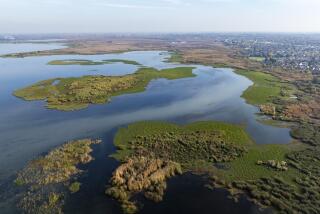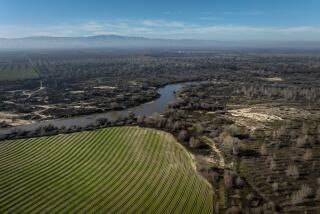A journey of discovery on the L.A. River
Environmental activist George Wolfe has always believed the best way to know a river is to kayak it. So when the U.S. Environmental Protection Agency recently designated the entire Los Angeles River a “traditional navigable waterway,” he organized an expedition.
Toting a waterproof first-aid kit and a sack of binoculars, Wolfe led seven people clad in T-shirts, shorts, sun hats and life vests to a lush, eight-mile stretch of river bottom near Griffith Park known as the Glendale Narrows.
Awaiting them downstream were quiet pools draining into noisy chutes, strewn with shoes, clothing, shopping carts, tires and plastic bottles, and shaded by cottonwood trees, cane forests and cattails. Plastic grocery bags snared in tree limbs rustled in the breeze. The river was running warm, greenish and, as one of the kayakers put it, “smelly as old socks.”
Normally, the U.S. Army Corps of Engineers and the Los Angeles County Department of Public Works, which have operated the river for decades as a flood-control channel, would not allow such a voyage because of safety and water-quality concerns. In this case, however, they would neither approve nor deny a boating permit pending clarification of what is allowable in the river under the new EPA designation.
Wolfe’s party took advantage of that legal gray area, launching at dawn on a recent workday in one canoe and five brightly colored kayaks just south of Los Feliz Boulevard in Atwater Village — one of the few stretches of the Los Angeles River that has a soft bottom and still looks like a river.
It is a rambunctious urban patch of rumbling water, serene greenery and occasional homeless encampments, framed by slanting concrete walls rising to electrical power-line towers, set to an endless soundtrack of freeway traffic. Paddling on the murky water, the kayakers surprised hundreds of shorebirds and waterfowl. Huge carp darted past like bronze torpedoes.
Wolfe aimed for the trip to be a floating expose of what the river has become and its potential as a recreational area and nature preserve. In addition, he wanted to gauge the prospects of a program to conduct tours under the auspices of The River Project, a nonprofit organization.
“I’ve already got a name for our program: LA River Expeditions, and a waiting list of about 200 people wanting to take a trip with me,” said Wolfe, paddling into the current.
Along for the ride were Joe Linton, a frequent contributor to the L.A. Creek Freak blog and a former staffer of the nonprofit organization Friends of the Los Angeles River; Gabriela Castaneda, a naturalist at the Audubon Center at Debs Park; Dave Lumian, government liaison for the American Sailing Assn.; three Times staffers and Glen Jochimsen, who provided the kayaks.
Most people see the Los Angeles River from a freeway: a flood-control channel of treated water a few inches deep flowing between graffiti-marred concrete banks strewn with trash and occasionally polluted with chemicals illegally dumped in storm drains and gutters that empty into it.
Frequent catastrophic floods prompted civic leaders in the 1930s to transform the river into a flood-control channel to protect the burgeoning flatlands. Nearly the entire 51-mile river bottom was concreted over, except a few spots where the water table was too high.
Among them were the Glendale Narrows, which drain through downtown past blue-collar neighborhoods, industrial zones and levees rimmed with chain-link fences and barbed wire.
Awareness of the river as a natural resource began to grow in the 1980s when environmental groups put pressure on the county and Army Corps of Engineers. The waterway is slowly being transformed into a greenbelt of parks, trees and bike paths as a result of a statewide recreational bond measure approved by voters.
Now, it has been formally christened a navigable waterway, subject in its entirety, from Chatsworth to Long Beach, to the protections of the federal Clean Water Act.
Still, the kayakers ran aground a mile downstream beneath the Glendale-Hyperion Bridge, an important artery in the city’s history. Dragging his boat by tether, Linton marveled at the austere octagonal pylons of the massive structure built in 1927.
The bridge was originally named Victory Memorial Viaduct in honor of the veterans of World War I, he said. Empty platforms at the south end of the bridge’s piers historically supported a leg of the Red Car commuter rail line.
“This was the first $1-million bridge built in Los Angeles,” he said. “A city engineer at the time described it as ‘a jewel in a landscaped setting.’ ”
A few minutes later, the vessels were hurtling down shallow rapids that dropped 10 feet, leaving everyone sopping and exhilarated.
Overhead, an osprey hunted for fish near a Metro Rail facility. Thousands of shimmering young carp the size of half-dollars zigzagged in the shallows. Pigeons sipped groundwater burbling out of fissures in the channel’s concrete shoulders. Sirens and horns blared in the distance.
Savoring the sights and sounds, Castaneda said, “This is the most exciting thing I’ve done in downtown Los Angeles since I moved here from Ecuador 11 years ago. It’s hard to believe we’re floating through the heart of one of the biggest cities on Earth.”
Lumian agreed. “I’ve kayaked around the world my whole life, but this particular trip is more than a little unusual. More people should see this place from the bottom up. Amazing.”
A fisherman seated on a felled palm tree greeted the passing kayakers with a smile. A group of Conservation Corps crew members pulling up weeds near the river’s edge waved hello. A woman with an infant in her arms and an incredulous expression on her face said in Spanish, “We come out here to look at turtles. We’ve never seen boats in here before.”
Residents of Frog Town, an area of Elysian Valley along the 5 Freeway that took its name from the amphibians that swarmed there before the channel was paved, expressed mixed feelings about the kayakers. Among them was Grove Pashley, a professional photographer who worried that increased recreational activities could harm wildlife.
“Los Angeles has this little hidden treasure which will only grow more popular as it gets discovered and developed as a green space for California residents,” he said. “My hope is that its wildlife is protected through thoughtful regulation of any boating or fishing that occurs.”
The expedition concluded under the 5 Freeway, where the soft bottom comes to an abrupt end. Pulling his boat ashore, Wolfe said, “With increased public access to this river it could be the heart and soul of the city again.”
U.S. Army Corps of Engineers Col. Mark Toy, the new commander of the Los Angeles district, agreed, up to a point.
On Wednesday, Toy and a dozen federal, county and city engineers and biologists in vehicles toured the Glendale Narrows on a mission to better mediate conflicting interests in the channel.
“The time has come,” he said, “to find a balance between flood control, recreation and habitat restoration on this beautiful river.”
More to Read
Start your day right
Sign up for Essential California for news, features and recommendations from the L.A. Times and beyond in your inbox six days a week.
You may occasionally receive promotional content from the Los Angeles Times.







